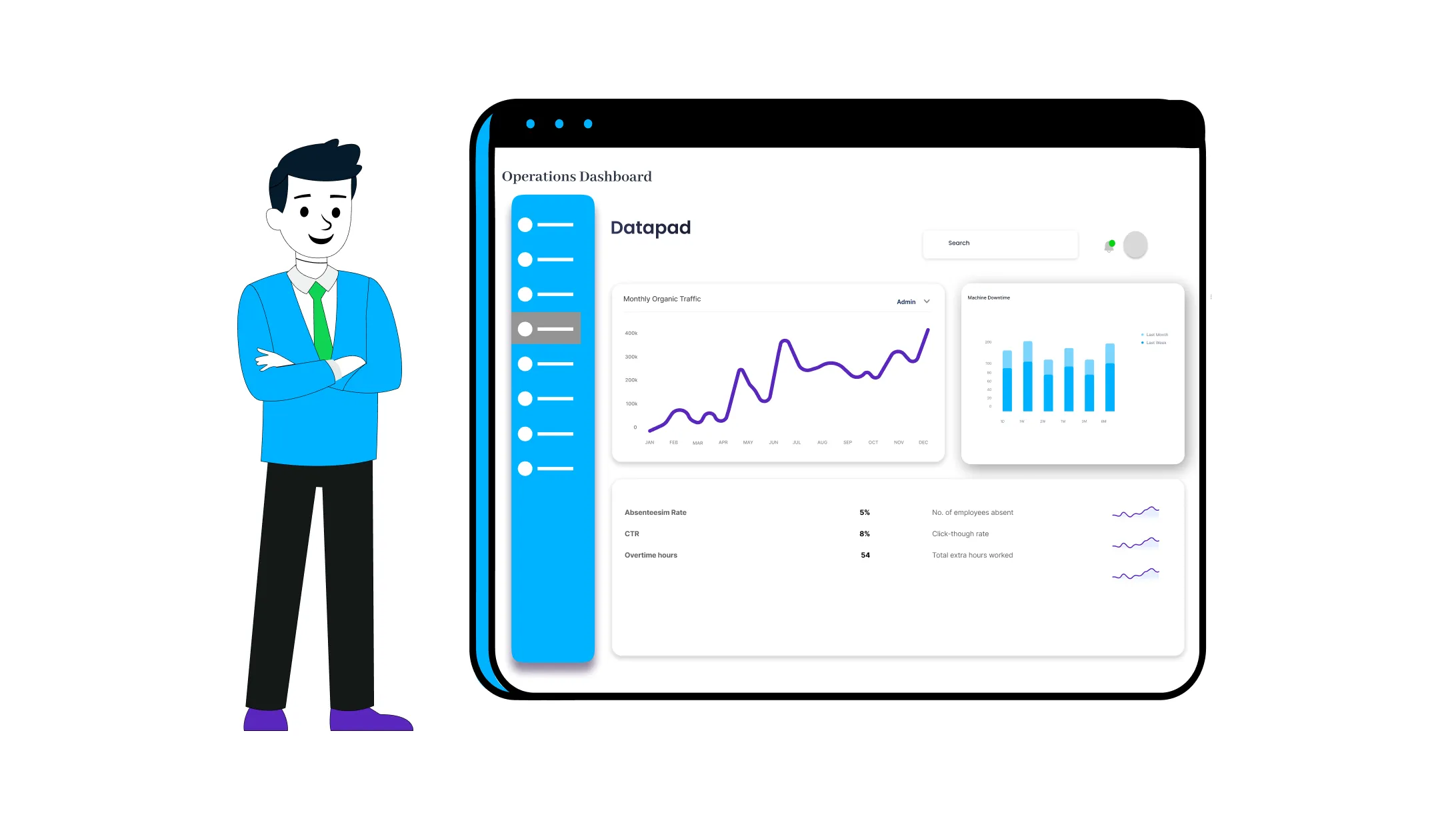Introduction to Sales KPIs

What Are Sales KPIs
Sales KPIs (Key Performance Indicators) are measurable values that indicate the effectiveness of sales activities. These metrics help sales teams and managers track performance, identify areas for improvement, and align sales strategies with business goals.
The Importance of KPIs in Sales Performance
1. Tracking Sales Performance:
KPIs like sales revenue and sales volume provide a clear picture of sales performance. For instance, if your sales team aims for $500,000 in monthly sales revenue, tracking this KPI ensures you're on target.
2. Identifying Improvement Areas:
Sales metrics and KPIs such as sales cycle length (which should ideally be within 4-8 weeks) and customer retention (aiming for a retention rate above 80%) highlight where sales processes need optimization.
3. Setting and Achieving Sales Goals:
Using KPIs for sales managers, like the number of qualified leads generated (targeting 50 leads per month), helps in setting realistic and achievable sales goals.
4. Enhancing Sales Strategies:
KPIs for business development managers, such as customer lifetime value (aiming for a range of $5,000-$8,000), inform strategy adjustments to maximize customer value.
How to Choose the Right KPIs for Sales

Choosing the right KPIs for sales involves identifying metrics that align with your business goals, sales strategies, and the specific roles within your sales team. Here are steps to help you select the most effective KPIs:
1. Align with Business Goals
Ensure your KPIs reflect your overall business objectives. For example, if your goal is to increase profitability, track average profit margin (aiming for a range of 3-8%) and customer acquisition cost (keeping it between 3-6%).
2. Focus on Sales Performance
Select KPIs that directly measure sales performance. Key performance indicators like sales revenue (targeting $4,000-$11,000 monthly) and sales growth (aiming for 6-11% growth) provide insights into your sales team's effectiveness.
3. Consider the Sales Process
Choose KPIs that monitor the efficiency of your sales process. Sales cycle length (ideally between 6-16 weeks) and the number of sales calls (targeting 1-2 calls per deal) can help streamline your sales operations.
4. Monitor Customer Metrics
Include KPIs that focus on customer-related metrics. Customer lifetime value (aiming for $5,000-$8,000) and customer retention rate (targeting 4-9%) are crucial for understanding and enhancing customer relationships.
5. Utilize Role-Specific KPIs
Tailor KPIs to specific roles within your sales team. For sales managers, focus on sales performance KPIs like the number of deals closed (targeting 4-8 per month) and sales team productivity (aiming for 7-9 team members hitting targets).
6. Leverage Predictive KPIs
Use KPIs that help forecast future performance. Monthly recurring revenue (targeting $2,000-$6,000) and the number of qualified leads (aiming for 2-7 per month) provide predictive insights into future sales trends.
7. Utilize Tools and Templates
Employ tools like KPI templates for sales to standardize tracking and ensure consistency in measuring performance across your sales team.
15 Examples of KPIs in Sales You Should Know

1. Customer Acquisition Cost (CAC)
Definition: Customer Acquisition Cost (CAC) measures the total cost of acquiring a new customer. It includes all expenses related to marketing and sales efforts.
Importance:
- Budget Allocation: Helps in understanding how much is spent on acquiring each customer, allowing for better budget allocation.
- Performance Measurement: Provides insights into the efficiency of marketing campaigns and sales strategies.
Calculation: CAC is calculated by dividing the total marketing and sales expenses by the number of new customers acquired within a specific period.
Example: If your company spent $50,000 on marketing and sales in a month and acquired 500 new customers, your CAC would be $100 ($50,000 / 500).
Benchmark: A typical target for CAC might be between 3-6 times the customer’s first purchase value, depending on the industry and business model.
2. Customer Lifetime Value (CLV)
Definition: Customer Lifetime Value (CLV) is the total revenue a business can reasonably expect from a single customer account throughout the relationship.
Importance:
- Profitability Analysis: Helps in understanding the long-term value of a customer and forecasting future revenue.
- Customer Retention Strategies: Identifies high-value customers, allowing businesses to focus retention efforts on these segments.
Calculation: CLV can be calculated using the formula:
CLV=(Average Purchase Value)×(Number of Purchases per Year)×(Average Customer Lifespan)
Example: If the average purchase value is $200, the customer makes 5 purchases per year, and the average customer lifespan is 3 years
Benchmark: Aim for a CLV that is significantly higher than the CAC. For instance, if your CAC is $100, a CLV of $3,000 indicates a healthy return on investment.
3. Sales Conversion Rate
Definition: Sales Conversion Rate is the percentage of leads that convert into actual sales.
Importance:
- Effectiveness of Sales Team: Measures how well the sales team is performing in converting leads into customers.
- Marketing Strategy Evaluation: Assesses the quality of leads generated by marketing campaigns.
Calculation: Sales Conversion Rate is calculated by dividing the number of sales by the number of leads and multiplying by 100.
Example: If you had 1,000 leads in a month and 50 of them converted into sales, your conversion rate would be: Conversion Rate=(50 / 1,000)×100=5%
Benchmark: A good conversion rate varies by industry, but a typical target might be between 3-8%. Continuously analyzing and improving this rate can lead to significant revenue growth.
4. Monthly Recurring Revenue (MRR)
Definition: Monthly Recurring Revenue (MRR) is the total predictable revenue generated by your business from all active subscriptions in a month.
Importance:
- Revenue Forecasting: Provides a reliable measure of your business's monthly income, essential for financial planning and forecasting.
- Growth Measurement: Tracks the growth or decline in recurring revenue, offering insights into customer retention and acquisition efforts.
Calculation: MRR can be calculated by multiplying the total number of active subscriptions by the average revenue per user (ARPU) for the month.
Example: If you have 200 active subscriptions and the average revenue per user is $50, then your MRR is: MRR = 200 x 50 = $10,000
Benchmark: A steady increase in MRR indicates healthy business growth. Aiming for a monthly growth rate of 5-10% can be a good target, depending on the industry.
5. Sales Cycle Length
Definition: Sales Cycle Length measures the average time it takes to convert a lead into a customer, from initial contact to closing the sale.
Importance:
- Sales Efficiency: Shorter sales cycles can indicate a more efficient sales process.
- Resource Allocation: Helps in planning and allocating resources, as longer cycles may require more sustained efforts and support.
Calculation: Sales Cycle Length is calculated by averaging the time taken to close deals over a specific period.
Example: If you closed 10 deals in the last month, with cycle lengths of 30, 40, 35, 50, 45, 60, 55, 70, 65, and 75 days, then your average sales cycle length is: Average Sales Cycle Length=30+40+35+50+45+60+55+70+65+75 / 10 = 52.5 days
Benchmark: The ideal sales cycle length varies by industry, but striving to reduce your cycle length by 10-20% annually can significantly boost sales productivity.
6. Customer Retention Rate
Definition: Customer Retention Rate measures the percentage of customers who continue to do business with you over a specified period.
Importance:
- Customer Loyalty: High retention rates indicate strong customer loyalty and satisfaction.
- Revenue Stability: Retaining customers is often more cost-effective than acquiring new ones, contributing to more stable revenue streams.
Calculation: Customer Retention Rate is calculated by dividing the number of customers at the end of a period by the number of customers at the beginning of the period, minus any new customers acquired during the period, and then multiplying by 100.
Example: If you had 1,000 customers at the start of the month, gained 100 new customers, and ended the month with 950 customers, your retention rate is: Retention Rate = (950−100/1,000)×100=85%
Benchmark: A good retention rate varies by industry, but many businesses aim for a retention rate of 85% or higher. Improving this rate can have a significant positive impact on your business’s long-term success.
7. Sales Pipeline Coverage
Definition: Sales Pipeline Coverage is a measure of the value of opportunities in your sales pipeline compared to your sales target for a specific period.
Importance:
- Forecast Accuracy: Helps in predicting future sales performance and revenue.
- Resource Allocation: Provides insights into whether you have enough opportunities to meet your sales targets, guiding resource and effort allocation.
Calculation: Sales Pipeline Coverage is calculated by dividing the total value of opportunities in the pipeline by the sales target.
Example: If your sales target for the quarter is $100,000 and the total value of opportunities in the pipeline is $300,000, your pipeline coverage is: Pipeline Coverage=300,000/100,000=3
Benchmark: A pipeline coverage ratio of 3:1 is often considered healthy, indicating that there are enough opportunities to meet the sales targets, accounting for potential losses and delays.
8. Average Deal Size
Definition: Average Deal Size is the average amount of revenue generated per closed deal.
Importance:
- Sales Strategy: Helps in understanding the effectiveness of sales strategies and the types of customers being targeted.
- Revenue Planning: Provides insights into the revenue potential and helps in setting realistic sales targets.
Calculation: Average Deal Size is calculated by dividing the total revenue by the number of closed deals in a specific period.
Example: If you closed 50 deals last quarter and generated $500,000 in revenue, your average deal size is: Average Deal Size=500,000/50=10,000
Benchmark: Aiming to increase the average deal size by focusing on upselling and targeting higher-value customers can significantly boost overall revenue.
9. Sales Win Rate
Definition: Sales Win Rate measures the percentage of deals that are successfully closed out of the total number of opportunities.
Importance:
- Sales Effectiveness: Indicates the effectiveness of the sales team in converting opportunities into closed deals.
- Process Improvement: Helps identify stages in the sales process that may need optimization to improve conversion rates.
Calculation: Sales Win Rate is calculated by dividing the number of closed deals by the total number of opportunities and multiplying by 100.
Example: If you had 100 opportunities last month and closed 20 deals, your win rate is: Win Rate=(20/100)×100=20
Benchmark: A good win rate varies by industry, but a target of 20-30% is common. Continuous analysis and improvement of sales techniques and processes can help increase this rate.
10. Customer Churn Rate
Definition: Customer Churn Rate measures the percentage of customers who stop doing business with your company over a specific period.
Importance:
- Customer Retention: High churn rates indicate issues with customer satisfaction or product/service quality.
- Revenue Impact: Understanding churn helps in assessing the impact on recurring revenue and planning retention strategies.
Calculation: Customer Churn Rate is calculated by dividing the number of customers lost during a period by the number of customers at the start of the period, then multiplying by 100.
Example: If you started the month with 1,000 customers and lost 50 customers by the end, your churn rate is: Churn Rate=(50/1,000)×100=5%
Benchmark: Aiming for a churn rate below 5% is ideal for most industries. Lower churn rates indicate strong customer loyalty and satisfaction.
11. Sales Activity Volume
Definition: Sales Activity Volume tracks the number of sales-related activities, such as calls, emails, meetings, and demos, conducted by the sales team.
Importance:
- Sales Productivity: Helps in understanding the productivity and efforts of the sales team.
- Lead Generation: More activities generally lead to more opportunities and conversions.
Calculation: Sales Activity Volume is the total count of all sales activities performed in a specific period.
Example: If your sales team made 500 calls, sent 300 emails, and held 100 meetings in a month, the total activity volume is: Sales Activity Volume=500+300+100=900
Benchmark: Setting specific targets for activity volume, such as 100 calls per week per salesperson, can help maintain consistent lead generation and pipeline health.
12. Lead-to-Opportunity Conversion Rate
Definition: Lead-to-Opportunity Conversion Rate measures the percentage of leads that are successfully converted into sales opportunities.
Importance:
- Lead Quality: Indicates the quality of leads generated by marketing and their potential to convert into sales.
- Sales Effectiveness: Helps in assessing the effectiveness of the sales team in qualifying and nurturing leads.
Calculation: Lead-to-Opportunity Conversion Rate is calculated by dividing the number of leads converted into opportunities by the total number of leads, then multiplying by 100.
Example: If you generated 1,000 leads last quarter and 200 of them became sales opportunities, your conversion rate is: Conversion Rate=(200/1,000)×100=20%
Benchmark: A good lead-to-opportunity conversion rate varies by industry but typically ranges from 10-25%. Higher conversion rates indicate effective lead generation and nurturing processes.
13. Sales Target Achievement Rate
Definition: Sales Target Achievement Rate measures the percentage of sales targets met by the sales team within a specific period.
Importance:
- Performance Tracking: Indicates how well the sales team is performing against set goals.
- Motivation and Incentives: Helps in designing incentive programs and identifying high performers.
Calculation: Sales Target Achievement Rate is calculated by dividing the actual sales by the sales target and multiplying by 100.
Example: If your sales target for the quarter was $500,000 and your team achieved $450,000 in sales, the target achievement rate is: Achievement Rate=(450,000/500,000)×100=90%
Benchmark: Aiming for a target achievement rate of 90-100% indicates that targets are challenging yet achievable, keeping the sales team motivated.
14. Sales Revenue Per Rep
Definition: Sales Revenue Per Rep measures the average revenue generated by each sales representative.
Importance:
- Individual Performance: Helps in assessing the performance of individual sales reps.
- Team Productivity: Provides insights into the overall productivity and effectiveness of the sales team.
Calculation: Sales Revenue Per Rep is calculated by dividing the total sales revenue by the number of sales reps.
Example: If your total sales revenue for the month is $500,000 and you have 10 sales reps, the revenue per rep is: Revenue Per Rep=500,000/10=50,000
Benchmark: Comparing the revenue per rep to industry standards and internal targets helps identify top performers and those needing additional support or training.
15. Sales Forecast Accuracy
Definition: Sales Forecast Accuracy measures the precision of your sales forecasts compared to actual sales results.
Importance:
- Planning and Strategy: Helps in refining sales strategies and planning by providing insights into the accuracy of sales predictions.
- Resource Management: Ensures that resources are allocated effectively based on reliable sales forecasts.
Calculation: Sales Forecast Accuracy is calculated by dividing the forecasted sales by the actual sales and multiplying by 100.
Example: If your forecasted sales for the month were $100,000 and the actual sales were $95,000, the forecast accuracy is: Forecast Accuracy=(95,000/100,000)×100=95%
Benchmark: A forecast accuracy of 90-95% is generally considered good. Regularly reviewing and adjusting forecasting methods can help improve accuracy.
16. Lead Response Time
Definition: Lead Response Time measures the average time it takes for sales representatives to follow up with a lead after initial contact.
Importance:
- Lead Conversion: Faster response times typically lead to higher conversion rates.
- Customer Experience: Prompt follow-ups improve the customer experience and demonstrate the company's responsiveness.
Calculation: Lead Response Time is calculated by averaging the time taken to respond to all leads over a specific period.
Example: If you had 50 leads with response times of 30, 40, 35, 50, 45, 60, 55, 70, 65, and 75 minutes, the average lead response time is: Average Lead Response Time=30+40+35+50+45+60+55+70+65+75/10=52.5 minutes
Benchmark: Aiming for a lead response time of under 30 minutes can significantly improve conversion rates and customer satisfaction.
17. Opportunity Win Rate
Definition: Opportunity Win Rate measures the percentage of sales opportunities that result in a closed deal.
Importance:
- Sales Effectiveness: Indicates how effective the sales team is at converting opportunities into sales.
- Process Improvement: Identifies areas in the sales process that may need optimization to improve win rates.
Calculation: Opportunity Win Rate is calculated by dividing the number of won opportunities by the total number of opportunities and multiplying by 100.
Example: If you had 100 sales opportunities and won 25 of them, the win rate is: Win Rate=(25/100)×100=25%
Benchmark: A win rate of 20-30% is common in many industries. Continuous training and process improvements can help increase this rate.
18. Monthly Sales Growth
Definition: Monthly Sales Growth measures the increase or decrease in sales revenue month over month.
Importance:
- Business Health: Indicates the overall health and growth trajectory of the business.
- Performance Tracking: Helps in tracking the effectiveness of sales strategies and identifying trends.
Calculation: Monthly Sales Growth is calculated by subtracting the previous month's sales from the current month's sales, dividing by the previous month's sales, and multiplying by 100.
Example: If the sales revenue last month was $80,000 and this month it is $100,000, the monthly sales growth is: Monthly Sales Growth=(100,000−80,000/80,000)×100=25%
Benchmark: Aiming for a monthly sales growth rate of 5-10% is typical for many businesses. Consistent growth indicates effective sales strategies and market demand.
How to Track Your Sales KPIs

Tracking sales KPIs effectively is essential for measuring the performance of your sales team, identifying areas for improvement, and making informed strategic decisions. Here’s an in-depth guide on how to track your sales KPIs:
1. Identify the Right KPIs
- Align with Business Goals: Ensure the KPIs you choose align with your overarching business objectives. For example, if your goal is to increase profitability, track metrics like customer acquisition cost and customer lifetime value.
- Role-Specific KPIs: Tailor KPIs to different roles within your sales team. For instance, track sales performance KPIs like deals closed per month for sales reps, and customer retention for account managers.
2. Set Clear Objectives
- Define Targets: Set clear, measurable targets for each KPI. For example, if you're tracking sales revenue, define a target such as $100,000 per month.
- Time Frames: Establish specific time frames for achieving these targets. Monthly, quarterly, and annual targets help in maintaining focus and consistency.
3. Use Sales Tracking Software
- CRM Systems: Implement Customer Relationship Management (CRM) software like Salesforce, HubSpot, or Zoho CRM to automate the tracking of sales activities and KPIs.
- Dashboard Tools: Use dashboard tools within your CRM or standalone solutions like Tableau and Power BI to visualize your sales KPIs in real-time.
4. Data Collection
- Automate Data Entry: Automate data entry as much as possible to reduce errors and save time. Many CRM systems allow integration with email, call logs, and other sales tools to automatically capture data.
- Manual Inputs: For metrics that require manual tracking, ensure there’s a standardized process in place. Regularly update the CRM with relevant data like meeting notes, deal stages, and follow-up activities.
5. Regular Reporting
- Daily and Weekly Reports: Generate daily and weekly reports to keep track of short-term performance. These reports can include KPIs like daily sales activity volume and lead response time.
- Monthly and Quarterly Reviews: Conduct in-depth reviews on a monthly and quarterly basis to analyze trends, compare performance against targets, and adjust strategies as needed.
6. Analyze Trends
- Historical Data: Compare current KPI data with historical performance to identify trends and patterns. For example, if your sales cycle length has decreased over the past year, analyze what changes contributed to this improvement.
- Benchmarking: Benchmark your KPIs against industry standards to see how your sales team stacks up. For instance, if the average deal size in your industry is $10,000, compare this with your own average deal size to identify potential gaps.
7. Adjust Strategies
- Identify Weaknesses: Use KPI data to pinpoint weaknesses in your sales process. If your lead-to-opportunity conversion rate is lower than desired, examine your lead qualification and nurturing processes.
- Implement Improvements: Based on the insights gained, implement changes to improve performance. This might include additional training for sales reps, refining sales pitches, or optimizing follow-up strategies.
8. Communicate Results
- Team Meetings: Regularly communicate KPI results to your sales team during meetings. Use these sessions to discuss successes, address challenges, and brainstorm solutions.
- Incentives and Recognition: Use KPI performance to structure incentive programs. Recognize top performers and provide rewards for achieving or exceeding targets.
9. Continuous Improvement
- Feedback Loop: Establish a continuous feedback loop where the sales team can provide input on the KPIs being tracked and suggest improvements.
- Adaptation: Be prepared to adapt your KPIs as your business goals and market conditions change. Regularly review and update your KPIs to ensure they remain relevant and aligned with your objectives.
Example of Tracking a Specific KPI: Monthly Sales Growth
- Set a Target: Define a monthly sales growth target, such as aiming for a 10% increase in sales revenue each month.
- Collect Data: Use your CRM to automatically track sales transactions and revenue data. Ensure all sales reps input their sales figures promptly.
- Generate Reports: Create monthly reports to compare the current month's sales revenue with the previous month.
- Analyze Results: If sales grew by 15% this month, analyze what factors contributed to this growth. Was it a new marketing campaign, an increase in sales activities, or seasonal demand?
- Adjust Strategies: If sales growth fell short, identify bottlenecks or challenges. Perhaps leads are not being followed up promptly, or there might be issues with product pricing.
- Communicate and Act: Share the findings with your team, celebrate successes, and implement action plans to address any issues.
Concluding Thoughts For Using KPIs in Your Sales Process
Effectively tracking KPIs is essential for driving sales performance and achieving business goals. Key metrics like customer acquisition cost, customer lifetime value, and sales conversion rate provide valuable insights into sales operations. Tailoring KPIs for specific roles, such as sales reps, ensures alignment with overall objectives.
Monitoring KPIs helps improve the sales cycle, enhance strategies for existing customers, and boost customer retention. Implementing sales tracking software and regular reporting allows sales and marketing teams to visualize performance and make data-driven decisions.
By continuously analyzing trends, adjusting strategies, and communicating results, you foster a culture of improvement. Leveraging the right KPIs empowers sales and marketing teams to work together effectively, optimizing processes and driving sustainable growth.








